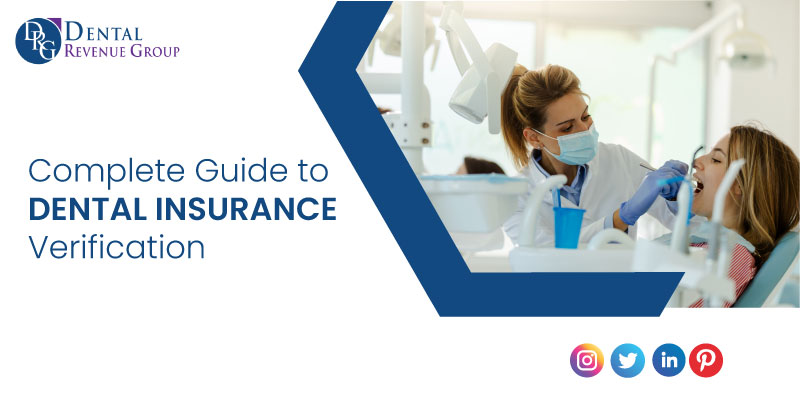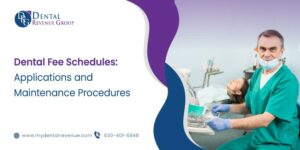The dental insurance verification process is one that you should expect as part of your dental billing process, but it’s also something that can help ensure you avoid getting stuck with unexpected bills later on down the line. A dental insurance verification service will help ensure that your office revenue maintains the lights on. Patients will frequently want you to file a claim on their behalf through a dental insurance plan. In this guide, we’ll discuss how to verify the dental insurance verification process and what information your dentist will need from you to get started.
What Is Dental Insurance Verification?
Dental Insurance Verification includes validating patient insurance eligibility for active coverage, dental insurance benefits, and prior approval of procedures ranging from cleanings to oral surgery. A patient’s insurance plan consists of four main components, which are as follows:
- Deductibles
- Coinsurance
- Copays
- Maximum out-of-pocket (MOOP) expenses
Before a patient’s visit, an insurance verification expert in your dental clinic should call the patient’s insurance provider to verify their dental insurance eligibility.
Dental Insurance Verification Process
The following steps are involved in the dental insurance verification process.
First, the dentist or their patient needs to obtain the necessary information to verify dental coverage, typically the patient’s name and the insurance company.
For example: if you’re looking at a dental plan for yourself or a family member, you can use an online tool to find out if your plan covers your out-of-pocket costs.
Next, the dentist will want to contact their insurance company and ask if they are a PPO provider.
The next step is to contact your insurance provider and ask if they are a PPO provider. A PPO plan is a type of dental insurance plan that allows you to choose from several different providers when it comes time for your regular check-ups and cleanings so that you can get the best price for your services. You’ll need to contact the dental office itself first, but once you know what type of insurance provider they are, then it’s easy enough to find out how much coverage would be offered through them as well!
To get started with the dental insurance verification process, you will need to hand over some information about yourself to your dentist’s office.
To start the dental insurance verification process, you will need to hand over some information about yourself and your insurance plan. This includes:
- Your name, phone number, address, and email address
- The name and policy number of your dental coverage
- A copy of your insurance card
- The name and address of your dentist or oral surgeon.
After you’ve filled out your form and submitted it, you have completed this portion of the dental billing process!
Now it’s time for your dentist or their staff to gather information about your dental insurance benefits from your insurance provider.
They will need to get a hold of some critical data that helps them process payments on their end but also ensures that you’re getting the best possible care.
The first step is for you (the patient) and your dentist or hygienist to go over the details about what type of plan you have and how much coverage it offers. This includes questions about whether or not there are any yearly limits on benefits; if so, which ones? If there aren’t any annual limits but instead per-visit fees or other charges from time to time—or even just monthly premiums—what happens when those occur?
When asked whether they’ve been making claims recently, you’ll also want an answer: Do they know why these requests were denied? If so, how can this affect future claims being made through the same insurer?
While the specifics of this part of the process will vary between different insurance providers, there are a few basics that are generally true across all dental insurance companies.
When you call the insurance company, they will ask you for basic information. The dentist will need to contact them and ask if they are a PPO provider. This means that your dental plan has a network of dentists who accept its coverage and can refer cases directly to each other without going through an administrative process as traditional fee-for-service plans use.
The insurance company will want to know the following:
- The name of your patient.
- Their address—specifically where it’s located within their city/state/country (if applicable). It’s worth checking with both yours and theirs before proceeding further into this process so there aren’t any surprises later down the road when trying.
It is important for both the dentist and their patient to understand what their current dental plan covers so that both parties can avoid a situation in which payment is unexpectedly due from the patient for a service not covered by their plan.
As a consumer, knowing your rights under each type of insurance coverage and how they work together is essential. The information below will help you understand how this works in practice:
It is always better to be safe than sorry when it comes to an understanding what is covered by your plan and what isn’t.
When it comes to dental insurance, the only way to know for sure if your plan covers certain services is if you ask your dentist. However, there are many reasons why this is not always an option:
- Your dentist may not be familiar with all of the details of your plan’s coverage or their own patients’ plans. You must ensure that any questions about coverage are directed at someone who knows what they’re talking about!
- You might be afraid of asking questions because it feels like a waste of time (or worse—like whining). The truth is that anyone who wants better health care should take advantage of every opportunity available! If nothing else, being proactive will allow us to feel better about ourselves and our choices when dealing with doctors and other health professionals.”
Once you’re comfortable with the results of this process, be sure to ask if any services are covered on a specific day of the week or during certain parts of each month.
Suppose your insurance policy says something like “for members covered under our network plan, Monday through Friday inclusive (excluding holidays)”. In that case, this plan would cover all dental treatments. However, if your policy says “Monday through Thursday inclusive (excluding holidays) only”, then only those days/hours are covered by this plan and not others. If you have any questions about your dental insurance coverage or how much coverage will be provided for each service visit, please get in touch with us.
Conclusion
We hope this information will help you understand how your insurance company verifies dental plans and why it’s essential to be prepared for the process. Remember that there are many other options besides dentists and hospitals, so if you want to avoid going through this process, find another dentist!











